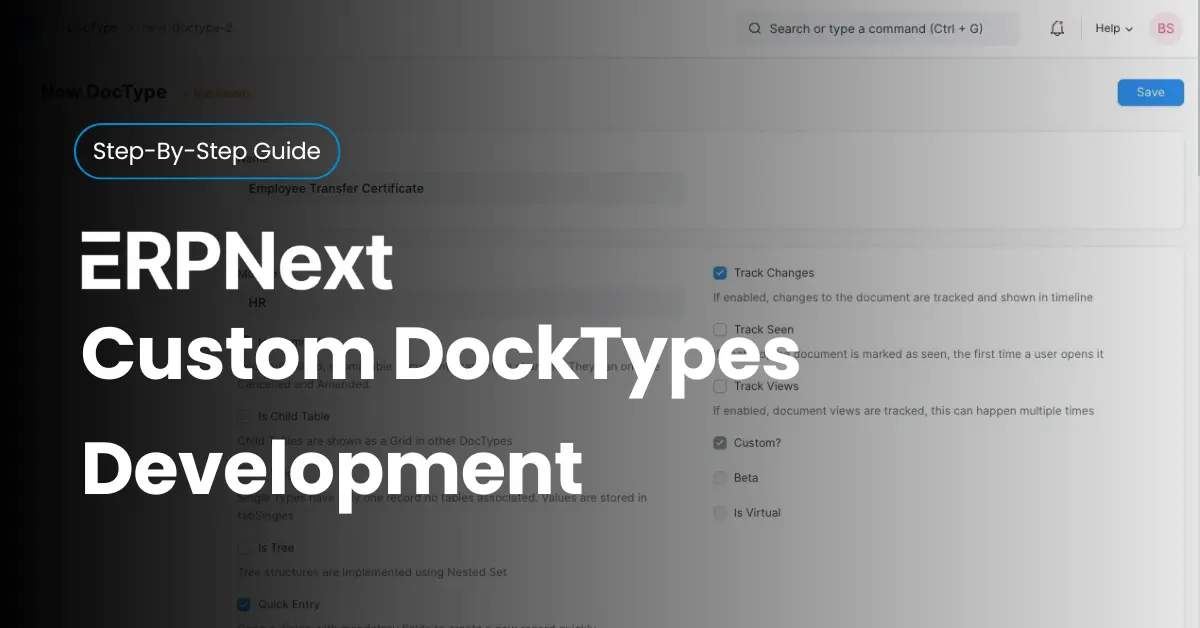Every business runs on data — customer details, inventory records, HR files, invoices, and approvals. But standard ERPNext forms can’t always match your company’s unique workflow. That’s where a custom DocType steps in.
A DocType defines how information is stored and displayed inside ERPNext just like Excel, but in ERPNext, it is customizable and integrable. Creating a custom one lets you model your exact process — whether it’s a “Vendor Quality Scorecard,” “Expense Approval,” or “Project Feedback” form.
For developers, it’s a flexible way to extend the Frappe Framework without altering core code. For business owners, it means fewer spreadsheets and smoother automation.
In this guide, you’ll learn how to create, configure, and optimize a Custom DocType in ERPNext — from developer setup to field creation, scripting, and workflow linking. The goal: help you build smarter, more adaptable ERP systems that actually fit your business.
What Is a DocType in ERPNext?
A DocType is the foundation of every module in ERPNext — think of it as a blueprint that defines how data behaves. Each form you use, from “Sales Invoice” to “Leave Application,” is built on a DocType.
Under the hood, a DocType defines fields, permissions, and relationships between data tables. When you create a new one, you’re essentially designing a custom database structure and user interface — no complex coding needed.
How DocTypes Power ERPNext Modules
In ERPNext, modules like Accounting, CRM, and HRM each contain multiple DocTypes. For instance, the HR Module includes “Employee,” “Leave Application,” and “Payroll Entry.” Together, they store and connect data that drives automation and reporting.
Standard vs Custom DocTypes
| Feature | Standard DocType | Custom DocType |
| Purpose | Core ERPNext functions | Tailored business needs |
| Editability | Limited | Fully editable |
| Upgrade-safe | Yes | Needs review after update |
| Example | Sales Order | Vendor Audit Report |
A standard DocType ships with ERPNext by default, while a custom DocType allows you to extend or replicate similar logic for specialized workflows.
Why Create a Custom DocType?
ERPNext covers a wide range of business functions — but no two organizations operate the same way. A custom DocType lets you capture your company’s specific processes without breaking ERPNext’s structure.
For example, a manufacturing firm might want to track machine maintenance logs, while a school could need a student feedback form linked to courses. Instead of creating external spreadsheets, a custom DocType keeps everything integrated and reportable within ERPNext.
Business Scenarios That Need Custom DocTypes
Here’s where custom DocTypes shine:
- Quality Management: Track supplier inspections or nonconformance reports.
- Human Resources: Manage training records or performance reviews.
- Finance & Procurement: Create approval workflows for vendor payments.
- CRM: Record follow-ups, campaigns, or lead scoring details.
That said, building your own DocType doesn’t require deep programming knowledge — the Frappe Framework offers a low-code interface to design forms, add fields, and apply logic visually.
Prerequisites: Enabling Developer Mode
Before creating any custom structure, you must enable Developer Mode in ERPNext. This setting ensures that every DocType you create is saved as a JSON file in your app’s module — allowing version control, portability, and safe updates.
Developer Mode is like opening the workshop — it gives developers access to the blueprint layer of ERPNext, where you can define fields, permissions, and custom scripts without affecting standard components.
How to Enable Developer Mode
You can enable it in two ways:
- Via Command Line:
bench set-config developer_mode 1bench restart
- Via site_config.json:
- Add the following line inside your site configuration file:
"developer_mode": 1
After enabling, reload your ERPNext instance. You’ll notice new options under Developer > DocType, allowing you to create, edit, or export doctypes.
Why Developer Mode Matters
When you create a custom DocType in Developer Mode, ERPNext saves its configuration as code instead of database-only entries. That means:
- You can version-control your work using Git.
- Updates won’t erase your customizations.
- You can migrate doctypes between sites easily.
For long-term projects or client implementations, this is essential for data consistency and maintainability.
Step-by-Step Process to Create a Custom DocType
Creating a Custom DocType in ERPNext is simple when you follow a structured approach. Each step defines how your data behaves, connects, and displays inside the system.
Step 1: Open the Developer Module
In your ERPNext dashboard, go to Developer → DocType → New. This is where you start defining the structure. Only users with Developer access can see this option, so ensure permissions are in place.
Step 2: Define the Basic Fields
Enter the DocType Name, select a Module, and specify if it’s Custom. Decide whether it’s Single (no list view, only one record) or Table (used inside another form). This step lays the foundation of how ERPNext will handle your new data object.
Step 3: Add Custom Fields
Click “Add Row” to start adding fields like text, date, select, or checkboxes. You can define mandatory, read-only, or unique fields based on your business logic.
For instance, a Product Feedback DocType may include fields like “Customer Name,” “Product ID,” “Feedback Text,” and “Rating.”
Step 4: Configure Permissions
Assign role-based permissions to control who can create, read, edit, or delete data. ERPNext allows fine-grained access control, helping maintain data integrity and security across departments.
Step 5: Save and Test
Once you save the DocType, ERPNext automatically creates a corresponding database table and form interface. Open the form, enter test data, and verify field behavior and validations before deploying it for actual users.
Understanding Field Types and Options in DocTypes
Each field type in ERPNext serves a unique purpose. Choosing the right one ensures better data structure and usability.
Text and Data Fields
Used for general information like names or descriptions. “Data” is best for single-line entries, while “Text Editor” supports multi-line input or formatted content.
Select Fields
Useful for predefined options such as Status (Open, In Progress, Closed). They ensure consistency and prevent data entry errors.
Link and Table Fields
Link fields: connect your custom DocType to another (e.g., linking Customer in a Sales Feedback form).
Table fields: allow embedding one DocType inside another — perfect for sub-records like order items or audit logs.
Check and Date Fields
Use Check for yes/no values and Date for scheduling or tracking. Together, they improve automation — for example, marking whether a record is verified and when it was last updated.
Best Practices for Designing a Custom DocType
A well-designed DocType not only captures data but also drives operational efficiency. Here’s how to make it reliable and scalable.
Keep It Business-Oriented: Every field should serve a real business purpose. Avoid unnecessary inputs that confuse users or slow down workflows.
Ensure Field Naming Consistency: Use clear and consistent names like customer_name or invoice_date. It simplifies future reporting and scripting.
Test Before Rollout: Create test records to check data flow, validations, and integration with other modules. Adjust field types or permissions as needed.
Real-World Use Cases of Custom DocTypes
Custom DocTypes are versatile and can transform how teams manage specific workflows inside ERPNext.
Manufacturing: A Production Log DocType can record machine downtime, material wastage, and operator performance. It provides real-time insight into shop-floor efficiency.
Sales and CRM: Businesses can build a Customer Visit Log or Discount Approval DocType to track approvals and customer touchpoints, reducing dependency on external tools.
HR and Payroll: Custom forms like Employee Training Feedback or Leave Exception Request simplify internal HR documentation without third-party apps.
That said, the flexibility of ERPNext means each module can evolve with your processes — not the other way around.
Integrating Custom DocTypes with Workflows and Reports
Once created, your DocType can easily integrate with workflows, print formats, and reports to extend functionality.
Automating Workflows: Define workflow states (e.g., Draft → Approved → Completed) to standardize approvals. Assign actions and notifications automatically based on user roles.
Custom Reports and Dashboards: With ERPNext’s Report Builder, you can create custom filters and charts using your new DocType’s fields. For example, a Feedback Analysis dashboard can visualize satisfaction trends or highlight pending reviews.
Troubleshooting Common Issues
Even experienced users may face issues while creating or deploying a custom DocType. Here are a few quick fixes.
Issue 1: Missing Permissions:
If users can’t view or edit your DocType, revisit Role Permissions Manager to ensure roles are mapped correctly.
Issue 2: Validation Errors:
Field dependencies or incorrect naming conventions can trigger validation failures. Review field types and ensure mandatory fields are correctly configured.
Issue 3: Integration Failures
If your DocType isn’t linking properly with another module, check the Link field target and verify the referenced DocType exists and is published.
Maintaining and Updating Custom DocTypes
Building is only half the work — maintaining your custom DocTypes ensures they continue performing smoothly as your ERP evolves.
Version Control: Always export custom DocTypes to JSON and commit them to version control systems like Git. It helps recover previous configurations if something breaks after an update.
Monitor Field Usage: Use ERPNext’s Customize Form tool to track and clean up unused or redundant fields over time.
Update Scripts and Permissions: When upgrading ERPNext versions, revalidate your custom scripts, roles, and field references to ensure compatibility.
Why Custom DocTypes Matter for Long-Term ERP Scalability
Custom DocTypes let your ERPNext system grow with your business instead of limiting it. By tailoring data models, you ensure teams capture only what’s relevant — improving data quality, automation, and reporting accuracy.
Here’s why it matters: standardized customization leads to faster adoption, fewer manual workflows, and smoother scalability when your business expands.
That’s the real power of ERPNext — flexibility with structure.
Frequently Asked Questions:
Hope these questions clear your remaining queries regarding custom docktypes creations:
Q1: What’s the main advantage of creating a Custom DocType in ERPNext?
You get a data structure that fits your workflow exactly — no spreadsheets or external tools needed.
Q2. Do I need coding skills to build one?
Not always. Basic DocTypes can be created using ERPNext’s built-in UI. Coding helps only for advanced scripting and automation.
Q3. Can I migrate Custom DocTypes safely during updates?
Yes — as long as you export them properly in Developer Mode and manage versions through Git.
Q4. How do I secure my Custom DocTypes?
Use role-based permissions and enable change tracking for audit visibility.
Q5. What’s the best way to test new DocTypes before deployment?
Always test in a staging site first to validate forms, permissions, and automation logic.
Conclusion
Creating a Custom DocType in ERPNext gives businesses control over their data design and workflow. Whether it’s tracking customer visits, managing quality checks, or handling custom approvals, DocTypes make ERPNext truly adaptable.
With thoughtful planning, testing, and integration, your custom DocType becomes more than a form — it becomes a building block for smarter, automated operations.
Related Articles:

